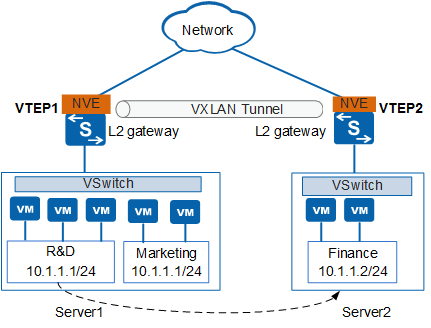Applying a Virtual Network in the VM Migration Scenario
Dynamic VM migration becomes a critical issue to meet flexible service changes. Dynamic VM migration is a process of moving VMs from one physical server to another, while ensuring normal running of the VMs. This process is also called smooth migration. End users are unaware of this process, so administrators can flexibly allocate server resources or maintain and upgrade servers without affecting server usage by end users.
The key of dynamic VM migration is to ensure uninterrupted services during the migration, so the IP and MAC addresses of VMs must remain unchanged. To meet this requirement, VM migration must occur within a Layer 2 domain but not across Layer 2 domains. In Figure 1, an enterprise has two servers deployed in a virtual network: Server1 providing services to the R&D and marketing departments, and Server2 providing services to the financial department. Because Server1 has insufficient computing space but Server2 is not fully utilized, the network administrator wants to migrate the R&D department to Server2 without service interruption.
The VXLAN technology can be used to establish a Layer 2 virtual network over any networks with reachable routes to implement Layer 2 interconnection. VXLAN encapsulates original packets sent by VMs over a VXLAN tunnel. VMs at two ends of a VXLAN tunnel do not need to know the physical architecture of the transmission network. In this way, VMs using IP addresses in the same network segment are in a Layer 2 domain logically, even if they are on different physical Layer 2 networks.
- The R&D department is migrated from Server1 to Server2.
- The VM in the R&D department sends gratuitous ARP or Reverse ARP (RARP) packets to instruct VTEP2 and other devices of the migration.
- After learning the gratuitous ARP or RARP packets, VTEP1 updates the MAC address table and ARP table to that of the VM after the migration.
After the R&D department is migrated from Server1 to Server2, VMs send gratuitous ARP or Reverse ARP (RARP) packets to update all gateways' MAC addresses and ARP entries of the original VMs to those of the VMs to which the R&D department is migrated.
